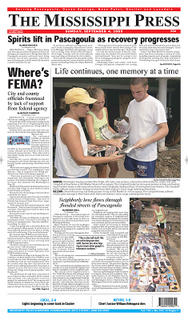 The Mississippi Press is publishing an on-line version of its daily newspaper. From Sunday's issue we read:
The Mississippi Press is publishing an on-line version of its daily newspaper. From Sunday's issue we read:An estimated 100,000 of 135,000 Jackson County residents are in need of housing assistance following Monday’s landfall of devastating Hurricane Katrina, county officials were told by a Red Cross’ national representative. They also need a dependable supply of water, ice, food and other necessities.With the intense political attention and media coverage of New Orleans, complaints are beginning to surface that the rest of the Gulf Coast is being ignored by FEMA and the national media. From an AP dispatch:
And like the county, officials in Gautier, Pascagoula and Ocean Springs say they are having trouble coordinating relief efforts with FEMA. “We’ve been scrounging for what little food we can find (for Gautier city employees),” said Wheeler. “This is supposed to be FEMA coordinated, but they’re not doing a good job.”
"Authorities along the coast and elsewhere complained of continuing neglect by the federal government. Donovan Scruggs, the director of community development for Ocean Springs, just east of Biloxi, said his city still didn't have an assigned coordinator at the Federal Emergency Management Agency.As for the media, the St. Petersburg Times is a notable exception. They've dispatched a number of reporters to Gulf Coast areas east of New Orleans who are filing small town stories daily.
"Outside assistance from FEMA has been pretty much nonexistent," he said.
To pick just three out of a wealth of them, Alex Leary has two splendid articles about Gulfport and Pearlington, and Michael Kruse dispatched a vivid account of life and death in Waveland titled Nothing But Sticks. Here's a taste of life transformed in rural Mississppi coastal towns:
From Gulfport:
Nearly a week after Hurricane Katrina struck, 13,000 Mississippians remained at 101 Red Cross shelters Friday. At the elementary school in Gulfport, 160 residents were still stranded.From Waveland:
They are among the saddest cases, their homes destroyed, jobs gone. Unable to reach family. If they had money to fill their gas tanks, they'd have no place to go. Many have only the clothes on their backs, or what they could find in garbage bags left by the more fortunate. Tensions have escalated as has the threat of disease.
City Hall is gone.From Pearlington:
The post office is gone.
The restaurants, the condos, the houses. Gone, gone, gone.
In this coastal town of about 7,000 people, on a wide swath of land that stretches about a mile up from the Gulf of Mexico, almost everything south of the railroad tracks is gone.
And the great big homes right on the beach? There's hardly any debris. Hurricane Katrina sheared them off their foundations and swept the remnants somewhere between here and U.S. 90, about 3 miles north.
This is a particularly poor, rural part of what is largely a poor, rural state, and this tiny town with a population of about 1,600 is especially isolated: The Stennis Space Center is a buffer zone to the north and the east, the Pearl River is to the west, and there's nothing but marsh that runs out to the Gulf of Mexico to the south.
* * *
In the storm's aftermath, though, it also meant Pearlington was one of the last places to get help - even though the eye came up the river here that runs along the Louisiana and Mississippi border.
"We went days without anybody coming to see us," said Lori Fricke, 35.
Most of the folks from this town stayed at the Space Center during the storm, but some stayed behind - and not all of them have been accounted for.
* * *
Eddie Bennett, Stacey's husband, said he has heard seven are dead. He started naming names.
Chad Ducote, 26, said four have been confirmed dead.
Pullman said two.
Donna Doyle, 25, said she has heard 25 people drowned in the gym at the school, but Eddie Bennett said that was a rumor.
"I've got to be careful in saying this," Pullman said a bit later off to the side, "but a lot of bodies haven't been recovered." He thinks a lot of the dead were swept into the river when the 20- to 30-foot storm surge retreated.







No comments:
Post a Comment